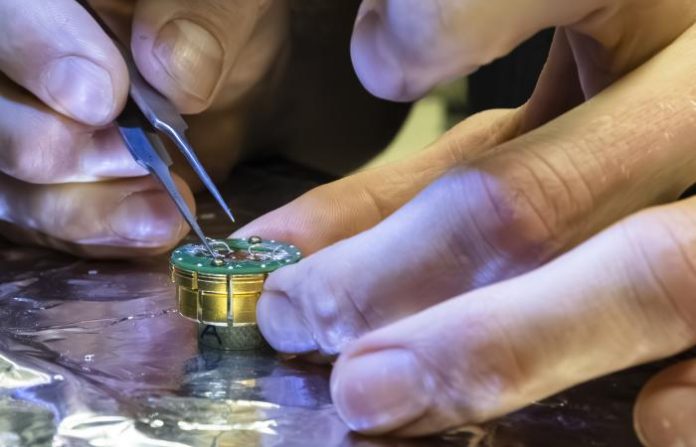Researchers created an ultra-thin superconductor by depositing specific elements and used advanced techniques, with ORNL scientists’ guidance, to study its topological properties and disorder
Research at the Department of Energy Oak Ridge National Laboratory aimed at a novel material system to enhance the durability and customise the functionality of qubits.
“We are pursuing a new route to create quantum computers using novel materials,” said ORNL materials scientist Robert Moore, who co-led a study published in Advanced Materials with ORNL colleague Matthew Brahlek, a materials scientist.
We are pursuing a new route to create quantum computers using novel materials
Challenges in lattice structures
They coupled a superconductor, known for its zero electrical resistance properties, with a topological insulator with electrically conductive surfaces but an insulating interior.
This fusion created an extremely precise interface between thin films composed of crystals with distinct atomic symmetrical arrangements.
The innovative interface they crafted through design and engineering could lead to the emergence of unusual physical phenomena and serve as a distinctive quantum component with the potential to excel as a superior qubit.
“The idea is to make qubits with materials that have more robust quantum mechanical properties,” Moore said. “What is important is that we have learned how to control the electronic structure of the topological insulator and the superconductor independently so we can tailor the electronic structure at that interface. This had never been done.”
Manipulating the electronic configuration on both sides of an interface can induce the formation of entities known as Majorana particles within the material. “In nature, we have particles and antiparticles, for example, electrons and positrons, which annihilate each other when they come in contact. A Majorana particle is its own antiparticle,” Moore said. In 1937, Ettore Majorana predicted the existence of these exotic particles, whose existence remains to be proven.
Previous research
In 2008, theoretical physicists Liang Fu and Charlie Kane from the University of Pennsylvania introduced the idea that establishing a unique interface between a topological insulator and a superconductor could lead to the emergence of topological superconductivity, a previously theorised phase of matter expected to accommodate Majorana particles.
Achieving a material capable of hosting Majorana particles depends on assembling a diverse team of experts.
Moore’s arrival at ORNL in 2019 brought expertise in ARPES (angle-resolved photoemission spectroscopy), a technique for studying a material’s electronic structure. ARPES uses a light source on a sample, observing electrons emitted from the material’s surface as they absorb energy from photons. This method helps scientists understand electron behaviour in materials.
ORNL’s investment in ARPES expertise led to its leadership in the Quantum Science Center (QSC), a DOE Quantum Information Science Research Center formed in 2020. The QSC, headed by Travis Humble at ORNL, focuses on advancing quantum computing, hardware, algorithms, and materials. Moore and his team work on developing topological materials for hardware.
Moore also co-directs ORNL’s Interconnected Science Ecosystem (INTERSECT), which aims to create advanced, autonomous laboratories for groundbreaking research.
Brahlek, who joined ORNL in 2018 and received a DOE Early Career Research award, specialises in precise material synthesis. He used molecular beam epitaxy, a method from the electronics industry, to create ultra-clean interfaces between superconductors and topological insulators.
He collaborated in depositing iron, selenium, and tellurium to create a superconducting material with just one atomic layer thickness. “If you can get the conditions exactly right, the deposited atoms will chemically bond and assemble, atomic layer by atomic layer, into a crystalline thin film,” Brahlek said.
“A key to getting the results was understanding how to combine bismuth telluride with iron selenide telluride at an atomic interface to gain the desired electronic behaviour,” Brahlek said.
Guidance from ORNL scientists
Achieving this was challenging because the lattice structure of the superconductor, composed of iron, selenium, and tellurium, consists of orderly square cells. At the same time, the topological insulator is constructed from interconnected triangles. Brahlek said. “This accomplishment requires understanding the physics and chemistry that happen at these interfaces, which is critical to combining topological and superconducting properties in a single platform.”
This platform is known as the topological superconductor. To investigate its unique properties, Moore employed spin-resolved ARPES with ORNL postdoctoral fellow Qiangsheng Lu’s assistance to examine the quantum spin-dependent electronic structure at the interface between the topological insulator and the superconductor.
“We were able to see how the different electronic structures were interacting at the interface, and we were able to control those interactions to ensure all the ingredients for topological superconductivity exist,” Moore said.
Editor's Recommended Articles
-
Must Read >> Data structures for quantum computing














